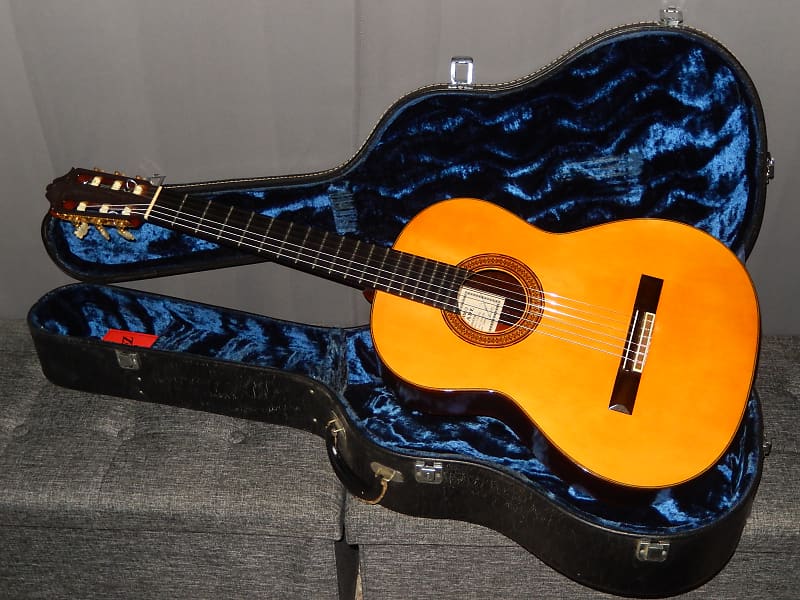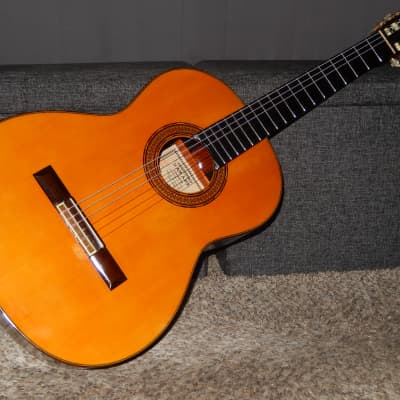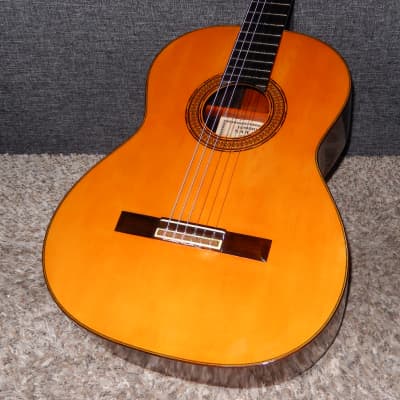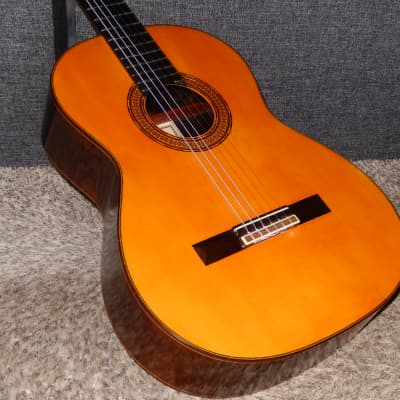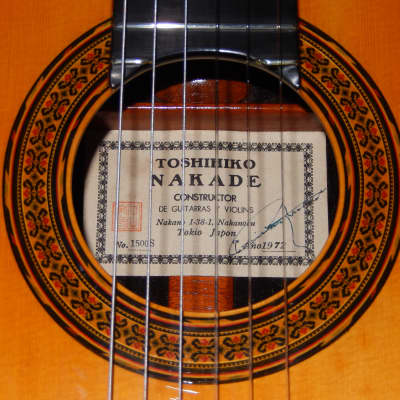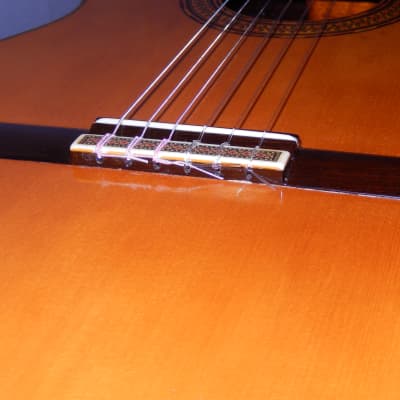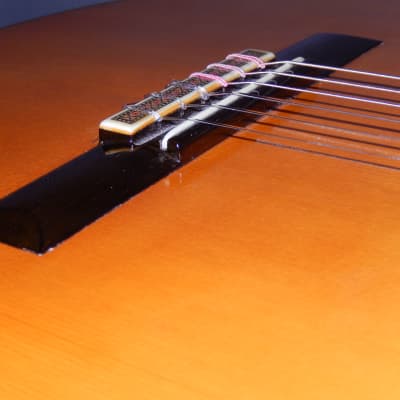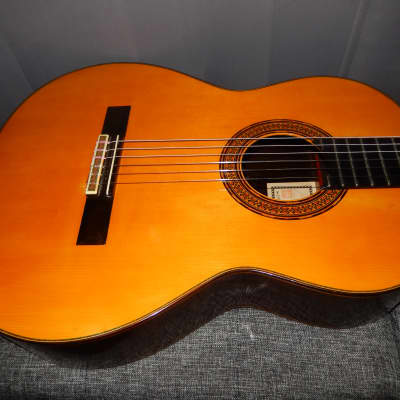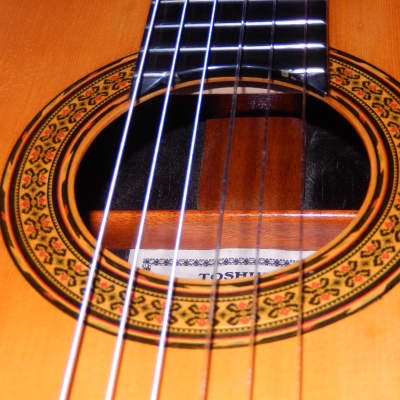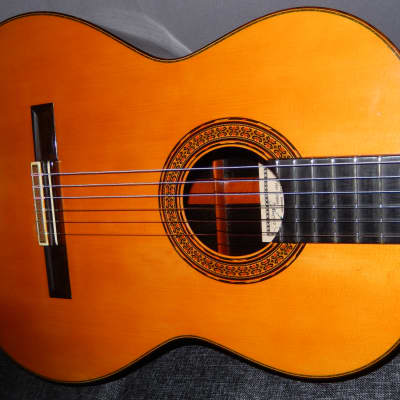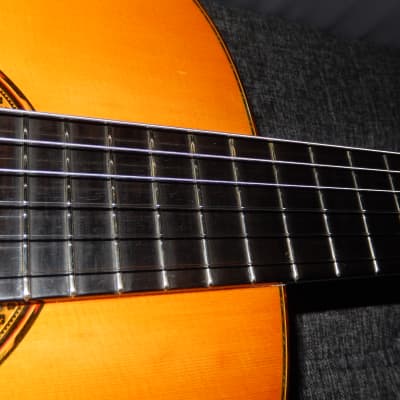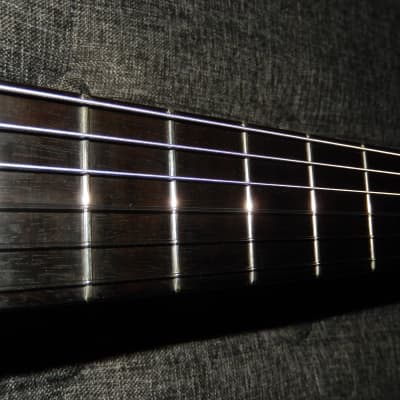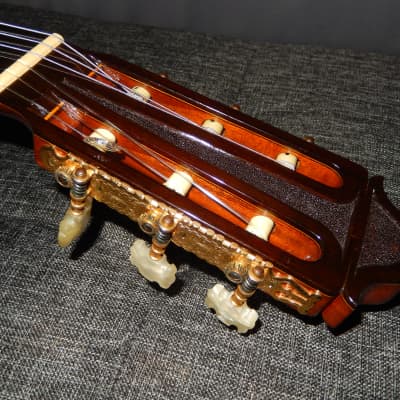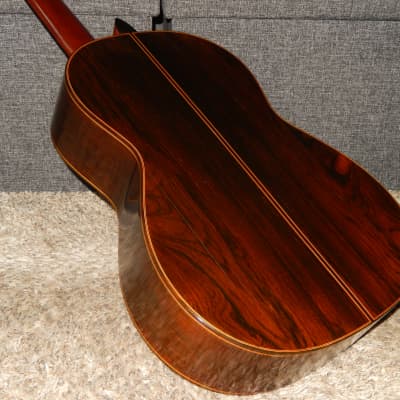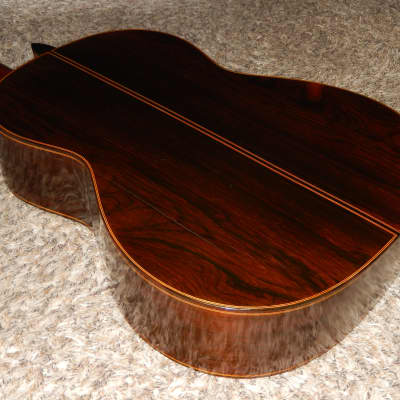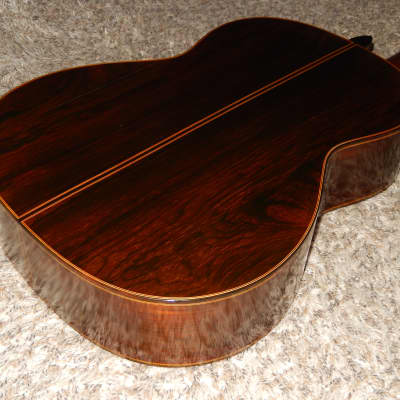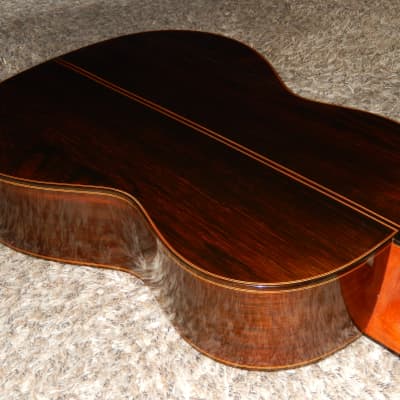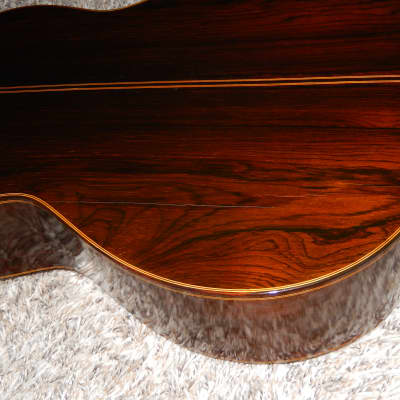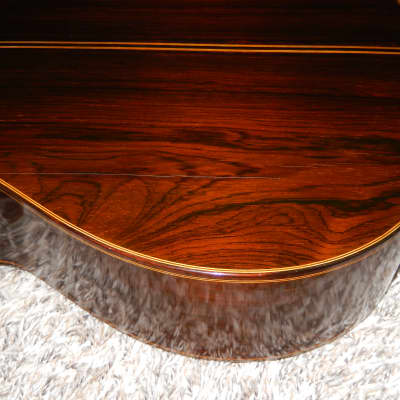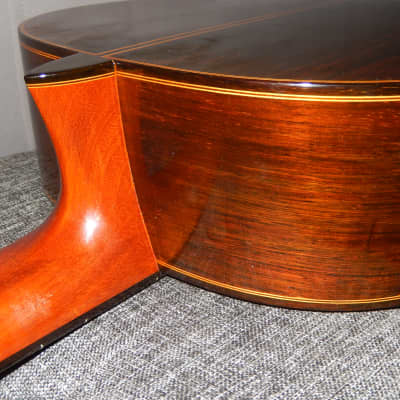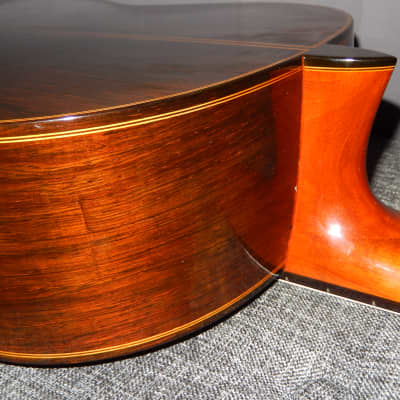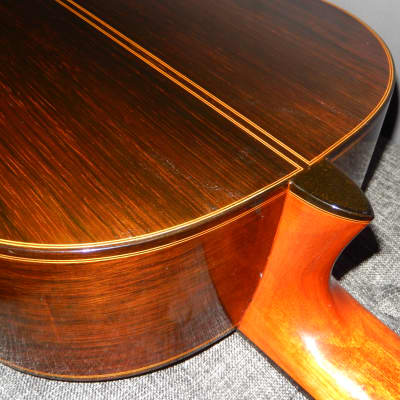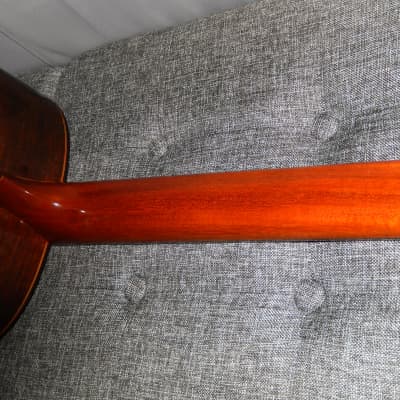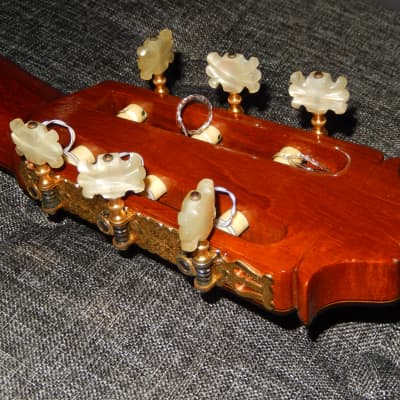Several hundred guitars I have sold in the past are presented at Facebook.com/Victors.Guitar.Library.
TOSHIHIKO NAKADE No.1500S 1972 Classical Concert Guitar
This wonderful guitar was made in 1972 by Toshihiko Nakade, one of highest regarded Japanese luthiers and top elite member over last 2 decades. His father Sakazo Nakade has been crowned by Japanese experts as “The Father of Modern Japanese Lutherie”.
Nakade Family Luthiers
Sakazo Nakade together with his older brother Rokutaro apprenticed under Japanese Master Violin Luthier Mr. Kinpachi Miyamoto in 1930’s.
Miyamoto had a chance to examine and measure Andres Segovia's performance guitar while he performed in Tokyo in 1929. Their master never ventured into guitar making, but the apprentices Nakade brothers did. They also went to Spain to study guitar making from the Spanish masters. Nakade guitars are high quality instruments and have a big following in Japan. They were famous in the early 60's before Masaru Kohno got famous in the late 60's.
During 1960s both brothers were famous, and their guitars equally highly regarded in Japan. Both brothers were selling their guitars at the same price level as Masaru Kohno. I believe that Rokutaro passed away in mid1970’s. Sakazo continued his work until his death in 1993 (at the age of 87). In the late 1960’s/early 1970’s he was joined by his 2 sons Teruaki, Toshihiko and later by his youngest son Yukio. Rokutaro's son Osamu Nakade, also travelled to Spain in early 1960's and started his own workshop after his return to Japan in 1970. Sometime in the 1990s Osamu Nakade designed a guitar model with top, back and sides made from bamboo, sold at very high prices.
Besides being trained by their father, Toshihiko and Teruaki went to Spain in mid 1960s, and studied at famous Hernandez y Aguado workshop for few years before opening their own workshops. Toshihiko started his independent career in 1968.
All Nakade luthiers were making very high-grade guitars and successfully competed with Masaru Kohno on Japanese market. Their workshops were never as huge undertakings as Kohno’s workshop hence their guitars were sold outside Japan in quite limited numbers. In fact, their guitars in many cases were of much higher grade than Kohno models sold for the same price.
In 1972 Toshihiko's model 1500S priced 150000 yen was his second from the top model (with model 2000S being the top one). By 1979 the same class guitar would be labelled as Master 30 and priced 300 000 yen. In 1972 only Masaru Kohno and Sakazo Nakade had 300 000 yen models. For several other elite makers 200 000 yen models were top of the line (like Yamaha GC20D or Hiroshi Tamura P200) while for several others 150 000 yen was the maximum they could charge for their best models (like R. Matsuoka No150, Kazuo Yairi YC150).
Toshihiko Nakade retired in July of 2021. In recent years his guitars were sold at very high prices, and nobody questions their greatness. His lowest classical models were priced minimum 600000 yen (at least $6000 in US distribution) while his model No100 (made with Spruce top & Latin America Rosewood b/s) was priced 1000000 yen (at least $10000 in US distribution). Toshihiko's flamenco guitars were made in very limited numbers and were always highly priced. His latest very top classical guitar models made in 2021 were Maestro (priced 1 100 000 yen) and Aguado (priced 1 430 000 yen). The same class guitars made in Spain are priced at least 50% higher.
This guitar offers everything that devoted player can ask for: terrific response & great volume, combined very lyrical, sweet, quite warm & moderately bright tonality, with superb note clarity and separation, clear piano-like trebles, deep and rich, cello-like basses, all well balanced and magnified by truly impressive sustain. This guitar is very hard to dislike.
The overall condition of this can be described as "at least very good for its age". Besides one string burn below the bridge and a few very minor marks within its shellac finish, the body of this guitar doesn't bear any conspicuous scratches or dents. It doesn’t have any structural flaws either. Its neck is straight, while fingerboard and frets remain in very good condition. Original tuners work fine.
What is visible from a close distance if looked at from certain angles is that original Frech Polish has aged enough to become “buttery”. It seems that previous owner(s) were trying to repolish its surfaces. Nevertheless, such shellac aging is very common on vintage guitars regardless of who was their maker.
What is not that obvious in regular light are a few crack lines on its back plates, with only one (few inches long) real crack. This crack has already been stabilized by the glue applied from the top and is also held firmly by back braces. Because this is clear glue, if you put the flashlight on the outside, you will still see the light sipping through on the inside.
Since you are interested in high end guitars and you need to know that among all tone woods used in guitar making, French Polished (shellac coated) figured Brazilian Rosewood is the most prone to cracking. Because of its very compacted fiber structure, if exposed to dry air surface of BR can become flaky with its outer layer cracking first. Straight grain BR plates are more stable than figured BR plates. For stability of figured BR plates any other finish is better than French Polish. BR coated with Japanese cashew lacquers is far more resilient. If you insist on playing French Polished guitar with solid figured BR b/s you must keep it away from dry and/or hot air.
As you correctly assumed, none of these (described above) imperfections affect the sound or playability of this gorgeous instrument.
Specifications:
Top: Very Fine Solid Spruce/7 braces fan/shellac
Back & Sides: Solid Brazilian Rosewood/ shellac
Neck: Mahogany
Fingerboard: Ebony
Scale: 658 mm
Nut width: 51 mm
Strings Savarez Cristal Normal Tension
The action is set to 4.00 mm under E6 and 3.50 mm with practically no extra room on the saddle.
This guitar will be shipped in used hard shell case in good condition.
Real Value of Japanese Vintage Guitars
The key to understand value of vintage Japanese guitars is to acknowledge galloping price inflation (devaluation of Japanese yen) during 1960s & 1970s. This inflation slowed down in 1980s.
During 1960s and most of 1970s model numbers of Japanese guitars were strictly interconnected with their prices in Japanese yen. By early 1980s and during following decades model numbers were no longer strictly associated with their prices. Some Japanese guitar makers introduced model names instead of model numbers. Others were still using model numbers with addition of letters and/or other symbols.
It is important to understand that two Yamaha GC10 guitars made 10 years apart are two instruments of totally different class. The same applies to any other Japanese maker/brand.
Any guitar priced 100 000 yen in 1970 (labelled usually as No10) would be priced 200 000 yen in 1975 (relabeled to No20 or 2000), 300 000 yen in 1977 (labelled as No3, No30 or 3000). Starting in 1977 Masaru Kohno introduced his new models No40 priced 400 000 yen and No50 priced 500 000 yen. By 1984 Kohno started using model names instead numbers and was raising their prices as he was pleased. The very top model 50 became model “Special”, and a decade later it became model “Maestro”. Naturally, all other Japanese guitar makers were doing the same pricing (labelling) upgrades.
Knowing all of that, you can bet on that Masaru Kohno No50 made in 1982 is practically the same grade instrument as Kohno No20 made in 1972, or Kohno no 30 made in 1975.
In 1970 the lowest Ryoji Matsuoka (all laminates) model was 10, followed by (solid top) models 15, 20, 25, 30, 40, 50, 60, 80 and (all solid woods) models 100 and 150. Models 60 and 80 were made with non-solid figured Brazilian Rosewood (double) b/s and top model 150 was the only one made with solid figured Brazilian Rosewood b/s.
In 1980 the lowest Matsuoka model was (all laminates) 20, followed by (solid top) models 30,40,50, 60 and all solid woods models 80,100,150 and 200. By 1990 the lowest Matsuoka model was M40 and the highest was M300. By 2010 the lowest Matsuoka model was M50 and the top model was M270.
You can bet that Ryoji Matsuoka model 50 from 1980 is of the same grade as model M100 from 2000, model 100 from 1980 is of the same grade as model M150 from 2000, model 150 from 1980 is of the same grade as M200 from 2000 and model 200 from 1980 is of the same grade as model M300 from 2000.
It is important to mention that if modern era luthiers are using 40+ years old woods to make an “all solid” wood classical guitar, its price is minimum $8000.
All vintage guitars made with Brazilian Rosewood are especially precious, including those made straight grain varieties and those with non-solid b/s.
Because response and tonal properties of Spruce soundboards are improving over time, long seasoned Spruces are far more precious than long seasoned Cedars.
It is not that very difficult to find out what are current prices of such guitars made by world’s leading luthiers.
Important message for Australian buyers:
USPS International Priority Mail packages destined for Australia have quite restricted size (max. length is 42” and max. length + girth is 97”). For these reasons I must use the case that is no longer than 41” and therefore it may be different than the one you see on the pictures. You should ask me for any other details prior to making a purchase.
